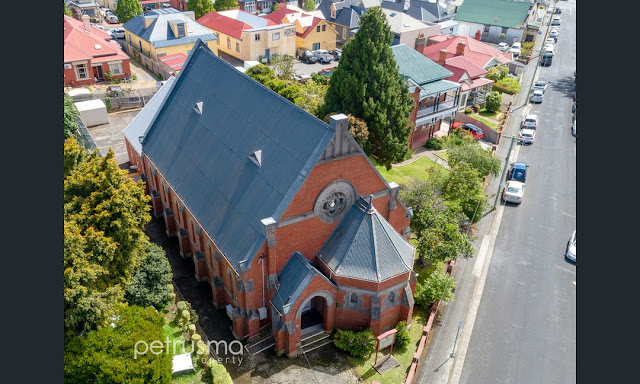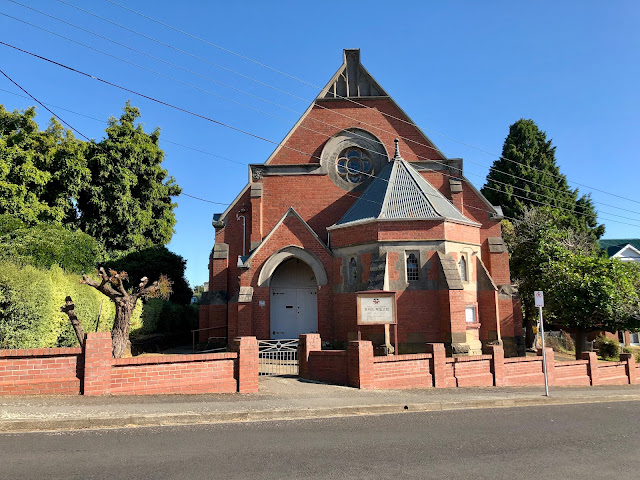No. 1266 - Sandy Bay Uniting Church (1904)
Sandy Bay is a southern suburb of Hobart. The northern half of Sandy Bay was known as Queenborough between the years 1859 and 1878.
The first Methodist church at Sandy Bay was a Primitive Methodist Mission Hall which opened in Princes Street in 1895. The 1902 Union between the Primitive Methodists and the Wesleyan Methodists soon created a need for a larger place of worship. Following the Union, proceeds from the sale of the Collins Street Primitive Methodist chapel was used to build a new church at Sandy Bay.
In early 1904 construction began on a new church at a site on Princes Street which was only a short distance from the old Mission Hall. The traditional ceremonial laying of the foundation or memorial stones was unusual in that seven stones were set, which was a record number for a Tasmanian church. The Mercury reported:
“There was a large attendance yesterday afternoon when the memorial stones were laid, among those present being Hon. T. Gant, M.L.C., Mr. A. E. Eckford, chairman, and members of Sandy Bay Town Board, and a number of the leading members of the Methodist body. After praise and prayer. Rev. H. Worrall made a few remarks, and called upon the different gentlemen to lay the memorial stones. There are, in all, seven of these stones, bearing an inscription notifying by whom they were laid. Stones were laid by Mr. G. Hiddlestone, Mr. J. Bidencope, Rev. H. Worrall (on behalf of Mr. C. Walch), Alderman Smith, Mr. C. D. Haywood, Mr. H. Jones, and Mr. J. Miller. Each of these gentlemen made suitable remarks, expressing the hope that the church might become the centre of much good work. They were each presented with a small mallet as a memento of the occasion….The contents of the bottle placed under the main stone were:—names and addresses of circuit members, names and addresses of the trustees of the Methodist Church, Sandy Bay; copy of preacher’s plan; copies of "Recorder and Methodist," "Mercury,"' and "Tasmanian News”.
The Mercury’s report went on to describe the new building:
“The building has been designed to accommodate 400 people. It is early decorated, or transition Gothic in character, and is to be built of brick, with stone dressings on a stone foundation. The front of the building is gabled, and has a porch entrance on one side of same, and an apse on the other side. There is a rose window in the gable, while the windows to apse have cusped heads, and the nave lancet windows. The whole building is strengthened, as well as adorned, by bold buttresses—these take the thrust of the roof. Internally the main floor is laid with a slope to enable all the congregation to see the pastor. The rostrum is approached by two flights of steps, and is arranged to have carved front. At the back of the rostrum (which is large enough to accommodate the choir) is an arched organ chamber, whilst two vestries have been provided. The roof is to be a framed open timber one, and is to be lined with narrow hardwood board".
The church was designed by architects Walker and Salier and the contract for construction was awarded to Mr William Cooper. The church was officially opened on Wednesday 3 August 1904. The Mercury reported:
“The ceremony was performed on Wednesday afternoon of opening the new Methodist Church which has been built in a central position in Princes-street, Sandy Bay….Close to the church has been built a parsonage. The house is of nice design, and substantially built of brick. It contains eight rooms. The cost of the church, parsonage, and land was £3,350. Cash and promises amounted to £1,500, and, £1,900 were borrowed….There were about 400 people present at the opening service. Amongst the ministers present were the Revs. R. Bayles (pastor), H. Worrell, H. E. Merriman, J. H. Cain, and J. Wilson, most of whom took part in the service, which was of the usual religious character. The Rev. W. A. Gann (Congregational) was also present…..The collections at this meeting amounted to £18 10s. A tea meeting was held in the school-room, and so large was the number of people attending it that three relays were necessary….”.
Following the opening of the new church the old Primitive Methodist Mission Hall was used as a Sunday school. In 1918 a kindergarten hall was added to the Sunday school. In 1929 the Princes Street Church separated from the Hobart Wesley Church to form the South Hobart Methodist Circuit. This situation continued until 1972 when the Sandy Bay church, along with the Davy Street Methodist church, reunited with the Wesley Church to become known as the Central Methodist Circuit Missions. In 1977 the Central Methodist Missions elected to become a part of the new Uniting Church.
In more recent years the Sandy Bay church was the home of the Korean Uniting Church. In 2022 the building was sold and will be converted into residences.
The first Methodist church at Sandy Bay was a Primitive Methodist Mission Hall which opened in Princes Street in 1895. The 1902 Union between the Primitive Methodists and the Wesleyan Methodists soon created a need for a larger place of worship. Following the Union, proceeds from the sale of the Collins Street Primitive Methodist chapel was used to build a new church at Sandy Bay.
In early 1904 construction began on a new church at a site on Princes Street which was only a short distance from the old Mission Hall. The traditional ceremonial laying of the foundation or memorial stones was unusual in that seven stones were set, which was a record number for a Tasmanian church. The Mercury reported:
“There was a large attendance yesterday afternoon when the memorial stones were laid, among those present being Hon. T. Gant, M.L.C., Mr. A. E. Eckford, chairman, and members of Sandy Bay Town Board, and a number of the leading members of the Methodist body. After praise and prayer. Rev. H. Worrall made a few remarks, and called upon the different gentlemen to lay the memorial stones. There are, in all, seven of these stones, bearing an inscription notifying by whom they were laid. Stones were laid by Mr. G. Hiddlestone, Mr. J. Bidencope, Rev. H. Worrall (on behalf of Mr. C. Walch), Alderman Smith, Mr. C. D. Haywood, Mr. H. Jones, and Mr. J. Miller. Each of these gentlemen made suitable remarks, expressing the hope that the church might become the centre of much good work. They were each presented with a small mallet as a memento of the occasion….The contents of the bottle placed under the main stone were:—names and addresses of circuit members, names and addresses of the trustees of the Methodist Church, Sandy Bay; copy of preacher’s plan; copies of "Recorder and Methodist," "Mercury,"' and "Tasmanian News”.
The Mercury’s report went on to describe the new building:
“The building has been designed to accommodate 400 people. It is early decorated, or transition Gothic in character, and is to be built of brick, with stone dressings on a stone foundation. The front of the building is gabled, and has a porch entrance on one side of same, and an apse on the other side. There is a rose window in the gable, while the windows to apse have cusped heads, and the nave lancet windows. The whole building is strengthened, as well as adorned, by bold buttresses—these take the thrust of the roof. Internally the main floor is laid with a slope to enable all the congregation to see the pastor. The rostrum is approached by two flights of steps, and is arranged to have carved front. At the back of the rostrum (which is large enough to accommodate the choir) is an arched organ chamber, whilst two vestries have been provided. The roof is to be a framed open timber one, and is to be lined with narrow hardwood board".
The church was designed by architects Walker and Salier and the contract for construction was awarded to Mr William Cooper. The church was officially opened on Wednesday 3 August 1904. The Mercury reported:
“The ceremony was performed on Wednesday afternoon of opening the new Methodist Church which has been built in a central position in Princes-street, Sandy Bay….Close to the church has been built a parsonage. The house is of nice design, and substantially built of brick. It contains eight rooms. The cost of the church, parsonage, and land was £3,350. Cash and promises amounted to £1,500, and, £1,900 were borrowed….There were about 400 people present at the opening service. Amongst the ministers present were the Revs. R. Bayles (pastor), H. Worrell, H. E. Merriman, J. H. Cain, and J. Wilson, most of whom took part in the service, which was of the usual religious character. The Rev. W. A. Gann (Congregational) was also present…..The collections at this meeting amounted to £18 10s. A tea meeting was held in the school-room, and so large was the number of people attending it that three relays were necessary….”.
Following the opening of the new church the old Primitive Methodist Mission Hall was used as a Sunday school. In 1918 a kindergarten hall was added to the Sunday school. In 1929 the Princes Street Church separated from the Hobart Wesley Church to form the South Hobart Methodist Circuit. This situation continued until 1972 when the Sandy Bay church, along with the Davy Street Methodist church, reunited with the Wesley Church to become known as the Central Methodist Circuit Missions. In 1977 the Central Methodist Missions elected to become a part of the new Uniting Church.
In more recent years the Sandy Bay church was the home of the Korean Uniting Church. In 2022 the building was sold and will be converted into residences.
 |
| Photography courtesy of Petrusma Property, Hobart |
 |
| Photography courtesy of Petrusma Property, Hobart |
 |
| Photography courtesy of Petrusma Property, Hobart |
 |
| The roll of Honour - source: Places of Pride |
 |
| The old Primitive Methodist Mission Hall on Princes Street which was used as a Sunday school after the new church opened. |
 |
| The rectory alongside the church |
Sources:
Tasmanian News, Wednesday 3 February 1904, page 4
Mercury, Thursday 4 February 1904, page 6
Tasmanian News, Thursday 4 February 1904, page 2
Mercury, Thursday 4 August 1904, page 8
Stansall, M. E. J and Methodist Church of Australasia Tasmanian Methodism, 1820-1975 : compiled at the time of last Meeting of Methodism prior to union. Methodist Church of Australasia, Launceston, Tasmania, 1975.

















Comments
Post a Comment